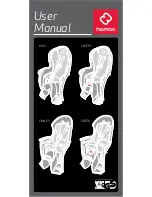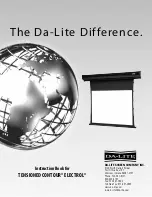
13
Electrical Input Check
Make preliminary check of evaporator fan ampere draw and verify
that motor nameplate amps are not exceeded. A final check of amp
draw should be made upon completion of air balancing of the duct
system (see Appendix B).
Refrigeration System
The unit is equipped with a thermal expansion valve as a meter
-
ing device.
Ensure the hold-down bolts on the compressor are secure and have
not vibrated loose during shipment. Check that vibration grommets
have been installed. Visually check all piping for damage and leaks;
repair if necessary. The entire system has been factory charged
and tested, making it unnecessary to field charge. Factory charges
are shown on the unit’s nameplate. To confirm charge levels or,
if a leak occurs and charge needs to be added to the system, it is
recommended to evacuate the system and recharge refrigerant
to unit nameplate specifications. This unit has been rated in the
cooling mode at the AHRI rated conditions of: Indoor (80°db /
67°wb) and outdoor (95°db).
While operating at this condition, the superheat and subcool for
each circuit for each unit should fall within the values listed in the
table below. The superheat is measured at the suction service
port located near the compressor. The subcool is measured at the
liquid line service port.
SUPERHEAT AND SUBCOOLING
Checking Subcooling
NOTE: Units with a TXV should be charged to Subcooling only.
Make sure the air flow is correct before making any adjustments.
EXAMPLE:
a. Liquid Line Pressure = 417 PSI
b. Corresponding Temp. = 120°F
c. Thermometer on Liquid line = 109°F.
To obtain the amount of subcooling, subtract 109°F from 120°F. The
difference is 11° subcooling. See the specification sheet or technical
information manual for the design subcooling range for your unit.
SUBCOOLING FORMULA = SATURATED LIQUID LINE TEMPERA-
TURE - LIQUID LINE TEMPERATURE
Checking Superheat
EXAMPLE:
a. Suction Pressure = 143 PSI
b. Corresponding Temp. = 50°F
c. Thermometer on Suction Line = 59°F
To obtain the degrees temperature of superheat, subtract 50.0
from 59.0°F. The difference is 9° Superheat. The 9° Superheat
would fall in the ± range of allowable superheat.
SUPERHEAT = SUCTION LINE TEMP - SAT. SUCTION TEMP.
Superheat Adjustment
NOTE:
Superheat adjustments should not be made until indoor
ambient conditions have stabilized. This could take up to 24 hours
depending on indoor temperature and humidity. Before check
-
ing superheat, run the unit in cooling for 15-20 minutes or until
refrigerant pressures stabilize. Use the following guidelines and
methods to check unit operation and ensure that the refrigerant
charge is within limits.
For TXV systems, to adjust superheat, unscrew the cover from
the expansion valve, locate the adjustment screw, and turn it
clockwise (in) to increase superheat or counterclockwise (out) to
decrease superheat. It is recommended to make small adjust
-
ments at a time, 1/8-1/4 turn increments. Replace adjustment
cap. Wait a minimum of 15 minutes between adjustments to
allow time for the TXV and pressures to stabilize.
Refrigerant Charge Check
NOTE:
For optimal performance, follow charging instructions
below.
Units with Fixed Orifice Devices
All package units with fixed orifice devices are charged using the
superheat method at the compressor suction line. To increase
super heat, remove charge and to decrease super heat, add
charge. After superheat is adjusted, it is recommended to check
unit subcooling at the condenser coil liquid line. See Figure 14:
DESIGN SUPERHEAT AND SUBCOOLING table for targets on each
model.
Units with Expansion valve (TXV)
Single Stage Cooling Application: Refer to the Design Superheat
& Subcooling table
Two-Stage Cooling Application: Run unit on Low Stage cooling
and refer to Design Superheat & Subcooling table.
1. Purge gauge lines. Connect service gauge manifold to
access fittings. Run system at least 10 minutes to allow
pressure to stabilize.
2. Temporarily install thermometer on liquid (small) line near
liquid line access fitting with adequate contact and insulate
for best possible reading.
3. Check subcooling and superheat. System should have a
subcooling and superheat within the range listed on the
Design Superheat and Subcooling table.
a. If subcooling and superheat are low, adjust TXV superheat,
then check subcooling.
NOTE:
To adjust superheat, turn the valve stem clockwise
to increase and counterclockwise to decrease. If an under
charge is suspected, recover the charge, re-evacuate the
system and recharge per data plate. No adjustments
should be made if suspecting a charge issue.
b. If subcooling is low and superheat is high, add charge to
raise subcooling then check superheat.
c. If subcooling and superheat are high, adjust TXV valve
superheat, then check subcooling.
d. If subcooling is high and superheat is low, adjust TXV valve
superheat and remove charge to lower the subcooling.
NOTE:
Do NOT adjust the charge based on suction pressure
unless there is a gross undercharge.
4. Disconnect manifold set, installation is complete.
Содержание DFC Series
Страница 47: ...47...
Страница 48: ...48...
Страница 49: ...49 THIS PAGE INTENTIONALLY LEFT BLANK...
Страница 50: ...50 THIS PAGE INTENTIONALLY LEFT BLANK...
Страница 51: ...51 THIS PAGE INTENTIONALLY LEFT BLANK...














































